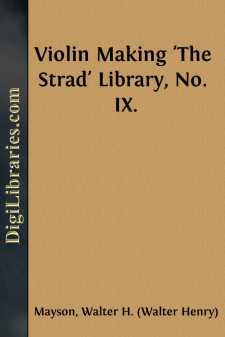Categories
- Antiques & Collectibles 13
- Architecture 36
- Art 48
- Bibles 22
- Biography & Autobiography 813
- Body, Mind & Spirit 142
- Business & Economics 28
- Children's Books 17
- Children's Fiction 14
- Computers 4
- Cooking 94
- Crafts & Hobbies 4
- Drama 346
- Education 46
- Family & Relationships 57
- Fiction 11829
- Games 19
- Gardening 17
- Health & Fitness 34
- History 1377
- House & Home 1
- Humor 147
- Juvenile Fiction 1873
- Juvenile Nonfiction 202
- Language Arts & Disciplines 88
- Law 16
- Literary Collections 686
- Literary Criticism 179
- Mathematics 13
- Medical 41
- Music 40
- Nature 179
- Non-Classifiable 1768
- Performing Arts 7
- Periodicals 1453
- Philosophy 64
- Photography 2
- Poetry 896
- Political Science 203
- Psychology 42
- Reference 154
- Religion 513
- Science 126
- Self-Help 84
- Social Science 81
- Sports & Recreation 34
- Study Aids 3
- Technology & Engineering 59
- Transportation 23
- Travel 463
- True Crime 29
Violin Making 'The Strad' Library, No. IX.
Categories:
Description:
Excerpt
INTRODUCTION.
Many admirable works on this interesting subject have appeared in several languages, but, to my mind, in a form too sternly technical, cold, if I may be allowed—the writers barely in touch with the anxious youth or man, who, as amateur, yearns to get at that knowledge of correct construction without which he scarce may hope to become a professional violin maker, some notable instances to the contrary, all the same.
I hold simplicity to be the very essence of the conveyance of matter from mind to mind, as in words; from mind to eye, as by pencil, brush, or chisel; palpable or otherwise, the impression intended should be beyond doubt, and that this end may be secured, mystification by high flown figures of rhetoric, or false drawing, or sculpture out of line or proportion, must at the outset of all work, art work above all, be sternly trodden under foot, and the solid and truthful experience of ripe years offered with the same eagerness to impart information as it is awaited by the student.
If you spend ten minutes in telling a man what form an oval assumes, when you can, by drawing it for him on a blackboard, present it before his eye in one minute, and more to the purpose, you not only waste your own time but his also, and commit a breach of trust, in that you mislead and mystify when it was your duty to faithfully guide and teach in all sincerity and simplicity.
Therefore I propose, in the following pages, to adopt an entirely different treatment from any work I have had the honour of studying on the construction of the violin; writing as though orally addressing the students, or those anxious to become students, of the whole world—a vast semicircle of bright faced, intelligent creatures before me, following eagerly every movement of the numerous tools I use in the extremely delicate manipulations of the instrument as it almost imperceptibly assumes that form so noble and so beloved, and almost devouring the, I hope, lucid explanations, which, from time to time, I may think it necessary to make, and which will appear as letterpress, the illustrations speaking for themselves as the work progresses.
This little thing that I am about to make, this shell of scarce sixteen ounces in weight, constructed of about eighty pieces of wood, and united by glue as one complete whole; this, that is a mighty factor, where mirth, and mirth only, is to the fore, in its embodiment; this, that draws from the soul the tear which has long yearned for an outlet of intense sympathy such as it now finds; this, that beautifies as it ennobles to the pinnacle of sublimity all music, even as it takes it by the hand, guides and cements it.
What is the origin of this violin or fiddle, and to what country does the honour belong?
To this day its origin, as a violin, is a contested point, and in my opinion will so remain; that is to say, how it worked its way, so to speak, out of now obsolete instruments, into what it is (for it was certainly a growth, not a complete conception), by whom it was so worked, and where—these points, aggravating points, if you will, seeing there is nothing of clearness around them, had better be left by you where they are; for, when Germany and Italy are supposed strong claimants, and assert a right not borne out by fact, according as I read the so-called evidence, it were futile to enter into discussion destined to have no satisfactory result....


